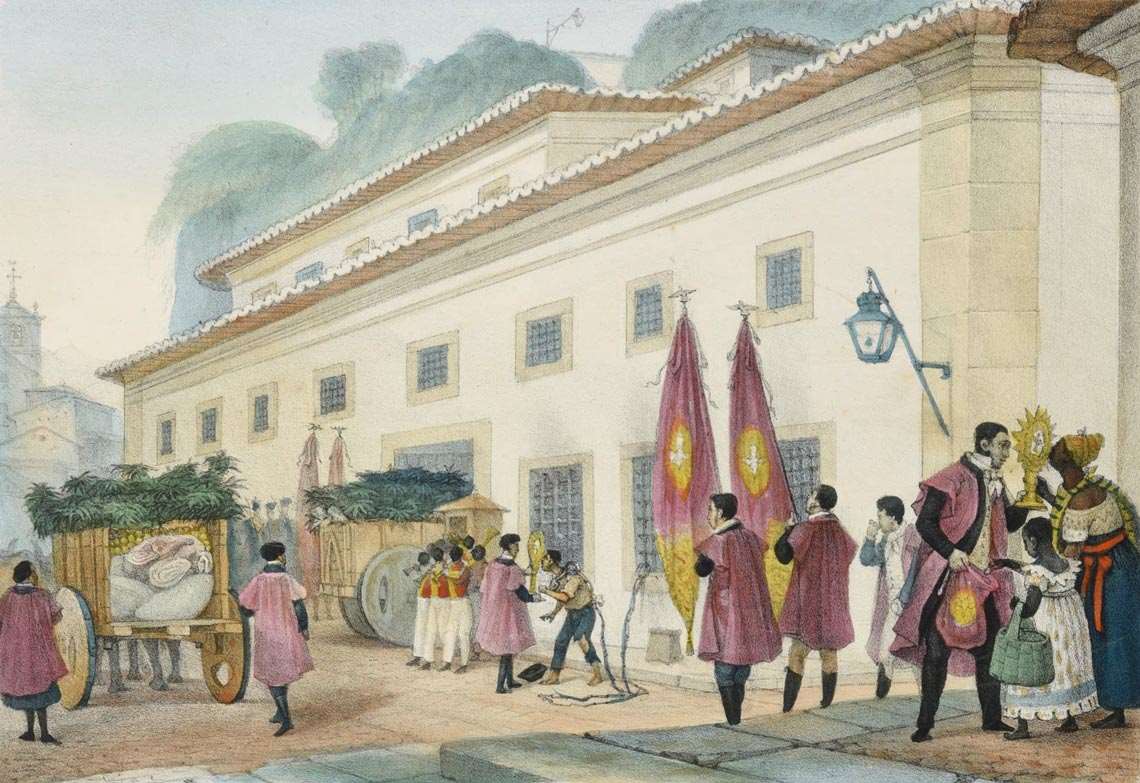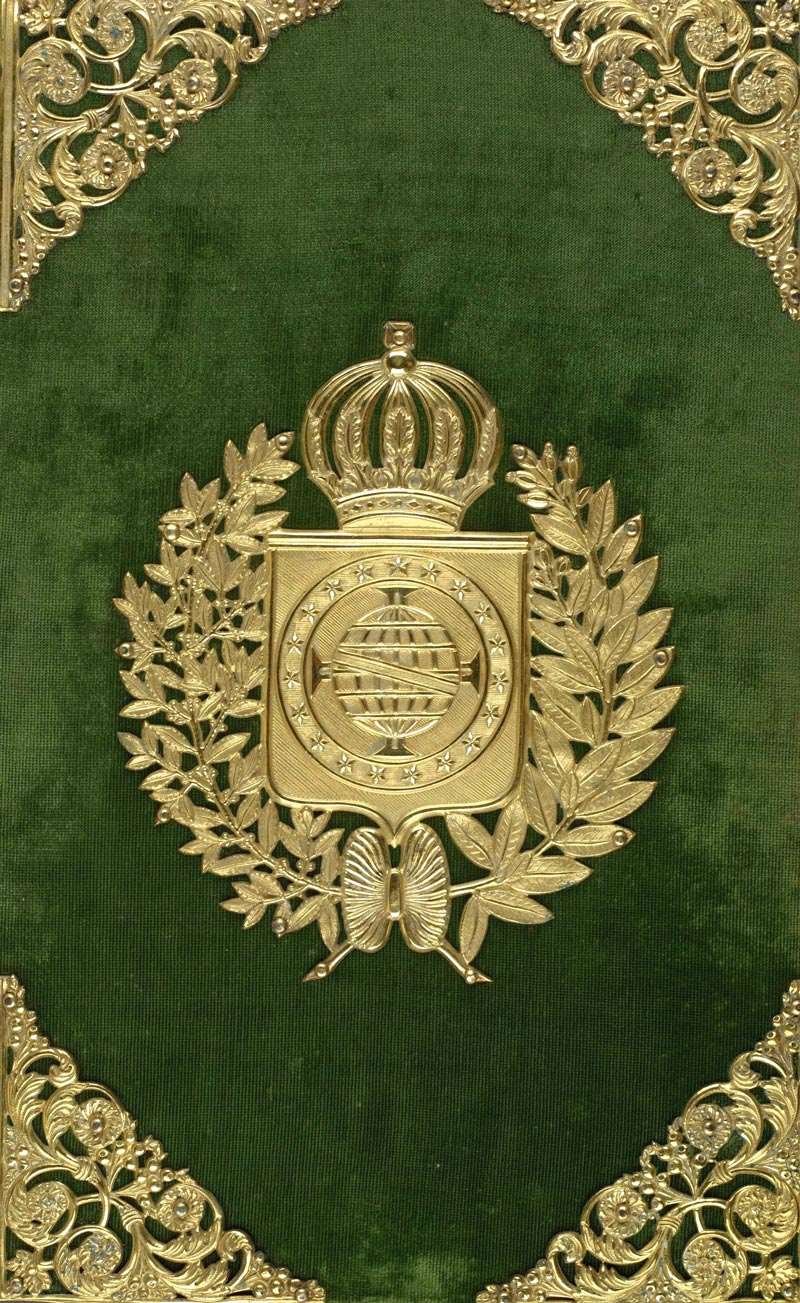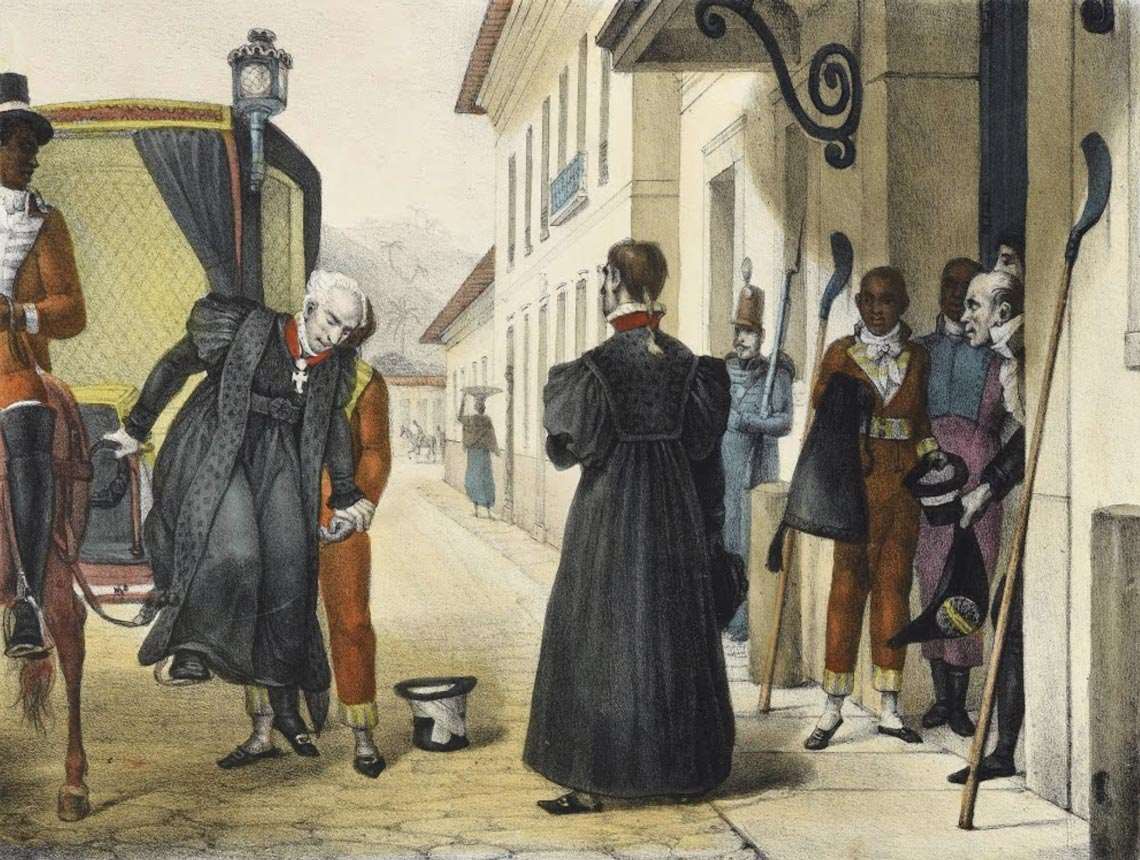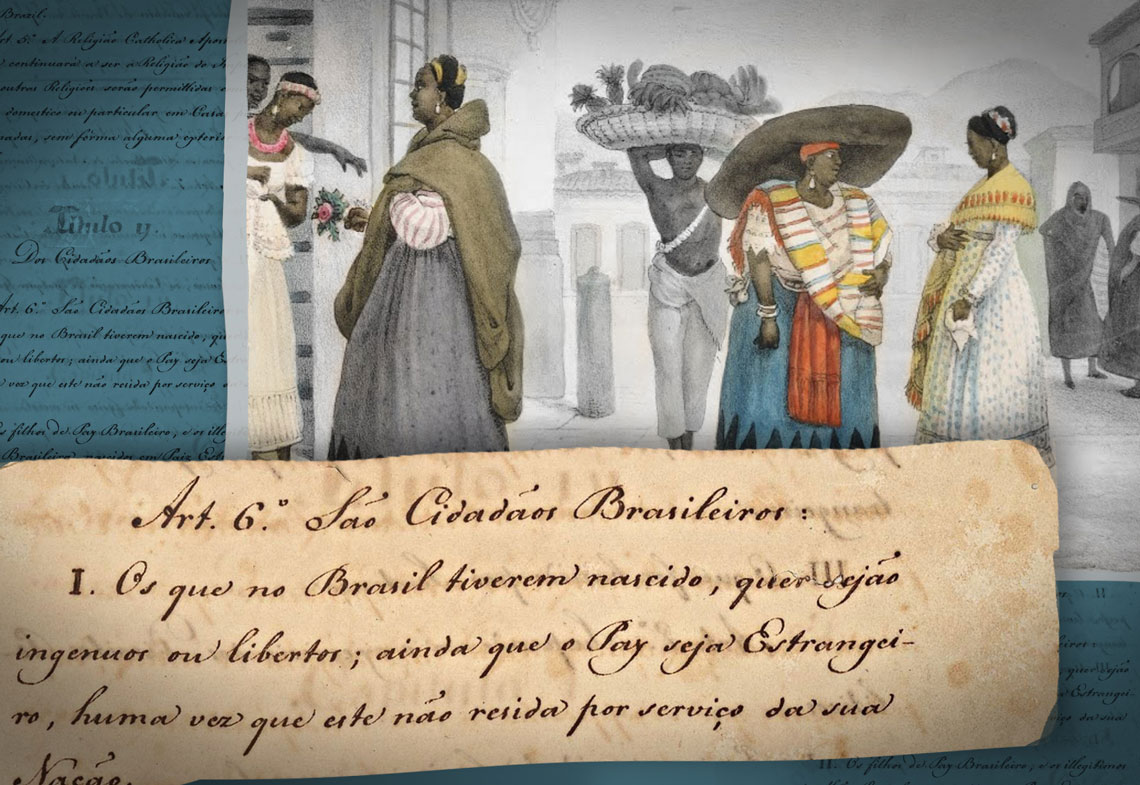In July 1826, a petition was filed before Brazil’s newly created Chamber of Deputies on behalf of an individual claiming to be a freedman unjustly imprisoned in Rio de Janeiro during a judicial dispute over his manumission. In their attempt to release Delfino from prison, his representatives evoked principles that had become prominent in that historical period: individual freedoms, constitutional rights, and the presumption of innocence. After a back-and-forth of appeals and counter-appeals, the case wound up in the Parliament.
An account of this episode is provided in a paper titled “Escravo até prove-se o contrário: Petição do liberto Delfino à Câmara dos Deputados (1826)” (Slave until proven otherwise: Freedman Delfino and his petition before the Chamber of Deputies [1826]), written by historians Adriana Pereira Campos and Kátia Sausen da Motta at the Federal University of Espírito Santo (UFES). Delfino’s story provides insights into many elements of Brazil’s early post-Independence justice system: the use of petitions, the role of the Parliament, and the struggles faced by slaves and freedmen. Brazil’s Declaration of Independence took place during a period characterized by major shifts but also continuity, and this was reflected in the country’s justice system.
The early nineteenth century was marked by transitions not only in Brazil but also in Europe and other countries in the Americas. In the wake of the American and French revolutions, constitutional and representative states began to gradually supplant the monarchies of the Old Regime. This transition had profound effects on justice systems and their institutions. Up until the previous century, the separation of powers as we know it today was nonexistent. “In the Old Regime, the monarch’s primary function was justice, defined as giving to each what is due,” says Monica Duarte Dantas, a historian at the Institute of Brazilian Studies at the University of São Paulo (IEB-USP). “The justice system was not grounded in the application of positive laws like today, but instead involved a number of other normative sources, written or otherwise.”
Magistrates’ decisions drew on multiple sources of law, including royal statutes (which were compiled into what in the Portuguese Empire were referred to as ordinances) as well as corpora of Roman law and canon law, legal theory, and local norms and customs, many of them unwritten. “Given that Brazil’s was a corporate society rather than a society of individuals, in administering justice one took into account the rights and privileges deriving from subjects’ social standing. Many interest groups not only had their own rules and practices, which were not hierarchically beneath Royal legislation, but also had their own private courts or judges. There was, for example, a Minters’ Court, which became defunct only in 1830. And the minters, like other interest groups that had their own body of law, could demand that any cases—even those involving their families—be tried in their private courts,” adds Dantas.
Brazil’s 1824 Constitution was modeled after the French Charter of 1824, drafted during the Bourbon Restoration after the fall of Napoleon Bonaparte (1769–1821) in 1815, explains José Reinaldo de Lima Lopes, at the USP School of Law. “It was moderately monarchical, with mechanisms that limited citizen participation and curtailed the people’s direct power, such as indirect elections and voting by census,” he says. The architects of the new political and legal system designed a “mixed government” model combining popular elements (such as elections), aristocratic elements (such as lifelong Senate seats), and monarchical elements (the Emperor). “The debates that took place in that period in Brazil reveal that a strong desire for change was tempered by fear of the passionate inclinations of the ‘masses,’ both freemen and slaves. The decades of bloody upheaval during the French Revolution were vividly remembered and frightening,” says Lopes.
This led to the creation of a very different justice system than the previous one. “It took years for government officials and civil servants to adjust. Judges, for example, continued to consult the government on certain cases,” notes Lopes. “Much of what we call private law—such as contract, property, family, and corporate law—continued to be governed by statutes and legal theory existing prior to Brazil’s Declaration of Independence. The Church retained its jurisdiction over family matters and over its own affairs.”
For Andreia Slemian, a professor of history at the Federal University of São Paulo (UNIFESP), although the 1824 Constitution did not immediately establish a modern national State, it did have the merit of introducing a new political model based on the rule of law and no longer on the rule of the monarch. “The first Constitution had less normative power than today’s, as many of the previous legal practices were maintained,” she notes. “But it was designed to establish a new society, governed by new principles. By introducing these principles, the Constitution laid the foundation on which the justice system would be built throughout the nineteenth century.”

Imperial Museum A detail in a painting by Jean-Baptiste Debret show supplies being delivered to prisoners in 1839Imperial Museum
The 1824 Constitution created a Supreme Court of Justice (STJ) to try privileged government officials, such as ministers, State councilors, diplomatic employees, and provincial presidents, and to review appeals adjudicated in the Courts of Appeal. The STJ began to function in 1828. But the former appeals court, or Casa de Suplicação, created in Brazil when the royal family arrived, would only become defunct in 1833. The Constitution also called for the drafting of new codes, including a Civil and a Criminal code. While the new codes were being drafted, the laws from the Colonial period remained fully or partially in force. The first two of these codes—the Criminal Code and the Code of Criminal Procedure—were adopted in respectively 1830 and 1832. A commercial code began to be drafted in the 1830s, but was only enacted in 1850. In the second half of the century, a bill for a Civil Code was introduced. It would only be enacted into law, however, in 1916.
The two codes introduced in the early 1830s superseded the penal legislation of the previous period and were landmarks in Brazil’s transition from Colony to independent nation. Civil legislation, on the other hand, retained its Colonial statutes, albeit with several amendments. “These amendments were made directly by legal theorists. A case in point were the Philippine Ordinances, drafted by Cândido Mendes [1818–1881] in 1870. He decided what would remain in effect and what would not,” says Slemian.
The 1824 Constitution introduced two major elements into Brazil’s justice system. Both reflected concerns over the proper operation of the judiciary. “Brazil’s justice system was not designed to address the needs of a mass society like ours, but primarily to tackle the legacy of corruption from the Colonial justice system, and judges’ arbitrary decisions,” says Lopes.
The first new feature was the use of juries in both criminal and civil cases. Juries were an invention of Anglo-Saxon countries that was later adopted during the French Revolution for criminal cases. In Brazil, juries were initially adopted for the crime of abuse of press freedom, and were then extended to all crimes in 1832. Juries were regarded, says Dantas, as a bastion of defense and protection of citizens’ rights. Although the Constitution also called for the use of juries in civil proceedings, this was never put into practice. And while many of the leaders of Hispanic American independence movements were advocating for the introduction of juries, they were only adopted in earnest decades later. According to Slemian, the use of juries also reflected a push for popular justice among Latin American revolutionary movements.
The second new feature was the election of justices of the peace—officials who discharged a wide range of duties without the need for legal training. Originally introduced in the Constitution to conduct mediation, in 1827 they were also tasked with maintaining public order, examining evidence, and hearing minor claims, both civil and criminal. In 1832, their duties were further expanded to include what today are known in Brazil as inquests. There was a justice of the peace in each parish or freguesia, then the country’s smallest administrative division. “Justices of the peace were closer to local communities than municipal authorities and even more so than judges, of which there was only one per district or comarca—most districts comprised multiple municipalities and therefore spanned vast areas,” says Dantas.

National ArchivesBrazil’s 1824 Constitution was modeled after the French Charter of 1824National Archives
Unlike deputies and senators, which were elected indirectly, councilmen and judges of the peace were elected directly by all enfranchised citizens, i.e. freemen above the age of 25 and with an annual income exceeding 100,000 réis, including the illiterate and freedmen. “This was a paltry sum at the time and became more so with inflation,” says Dantas. “People had more immediate access to justices of the peace than we do today, for example.”
Christian Lynch, a political scientist at the Institute of Social and Political Studies of the State University of Rio de Janeiro (IESP/UERJ), says the adoption of a jury system and the election of justices of the peace without legal training was part of a political decentralization movement led by local elites. In Brazil, these elites were largely landowners, slaveowners, and members of the government bureaucracy.
“These interest groups wanted a system modeled after the United States, including locally elected sheriffs and juries, because they loathed the Old Regime. They saw circuit judges and justices, which all had bachelor’s degrees, as representing the musty nobility of a centralized State,” he explains. “That is why they warmed to the idea of local judges and juries elected by the people. But Brazil did not have the same citizenry as European nations. As a country with a large population of slaves, most of the working class was disenfranchised. Who were ‘we the people?’ Slave owners. In a country such as this, federalism equated to feudalism,” he says.
In the 1840s, some of these innovations were abolished as part of a legislative reform. Duties previously assigned to justices of the peace were transferred to unelected officers appointed by the central government in Rio de Janeiro. This came about as part of the so-called “conservative regression,” in which the decentralization trend in Brazil was reversed.

São Paulo State PinacothecaJustices arriving at the Palace of Justice in Rio de Janeiro in 1839, in a painting by DebretSão Paulo State Pinacotheca
The use of petitions such as the one that freedman Delfino addressed to the Chamber of Deputies was a relic of the previous period, notes Slemian. “If a slave had purchased his freedom but his owner or his owner’s heirs refused to recognize it, there were two avenues available. The slave could either file a lawsuit or submit a petition to the governor, who had the power to inquire into the matter and to enforce the manumission,” he explains. Article 179, paragraph XXX of the 1824 Constitution, which established a new bill of rights, introduced the possibility of submitting complaints or petitions in either the legislative or the executive branch.
Slemian has previously done research on the so-called “courts of relation”—equivalent to present-day appeals courts—seated in Salvador, Rio de Janeiro, Recife, and São Luís. Although in Brazil they were essentially independent institutions and a component of the Judiciary, these courts also dealt with petitions not linked to legal proceedings. “Petitions had significant force in the previous legal framework. This shows that, despite all the criticism about the sluggish justice system and corrupt judges, there were effective ways for the general public to access justice,” he says.
Delfino’s petition reads: “the petitioner, as a freedman, is a citizen and as such cannot be arrested nor continue to be held in prison.” This phrase illustrates a peculiar aspect of the Constitution that had been approved a few years prior, in regard to one of the defining traits of Colonial Brazil: although slavery was mainstream in nineteenth-century Brazil, it was mentioned only one time, and only in passing, in the 1824 Constitution: “Article 6, paragraph I, states that all men born in Brazilian territory, ‘including freeborn and freedmen,’ were entitled to Brazilian citizenship.”
Thus, as described by Campos and Motta in their paper, Delfino’s representatives evoked the Constitution in asserting that, upon receiving his letter of manumission, he not only ceased to be a slave, but became a citizen. Moreover, the Bill of Rights under article 179 prohibited imprisonment without formal charges, introduced the possibility of bail, and allowed citizens to appeal against arbitrary imprisonment.
However, unfortunately for Delfino, the congressmen who adjudicated on his petition rejected these arguments. In their response, they stated that “the petitioner may not claim citizenship for so long as the matter of his manumission is not finally decided.” As a result, Delfino was obliged to await in prison a final decision by Brazil’s nascent justice system. A record of the final decision has never been found.
Projects
1. Remedies for justice: a study on judicial recourses in the courts of relation between the British Empire and Brazil (c. 1750–c. 1840) (nº 17/18137-3); Grant Mechanism Regular Research Grant; Principal Investigator Andrea Slemian (UNIFESP); Investment R$86,632.81.
2. Governments and judges: Issues in the administration of justice in Imperial Brazil (nº 15/23689-0); Grant Mechanism Research Grant – Visiting Researcher – International; Principal Investigator José Reinaldo de Lima Lopes (USP); Visiting Investigator Carlos Garriga Acosta; Investment R$34,520.68.
Books
LOPES, J. R. de L. História do direito e da Justiça no Brasil do século XIX. Curitiba: Juruá, 2017.
LYNCH, C. E. C. From Monarchy to Oligarchy: institutional history and Brazilian political thought (1822-1930). São Paulo: Alameda, 2014.
SLEMIAN, A. Sob o império das leis. Constituição e unidade nacional na formação do Brasil (1822-1834). São Paulo: Hucitec, 2009.
CAMPOS, A. P. and MOTTA, K. S. da. Escravo até prove-se o contrário: Petição do liberto Delfino à Câmara dos Deputados (1826). In: O espelho negro de uma nação. A África e sua importância na formação do Brasil. Vitória: Edufes, 2019.
